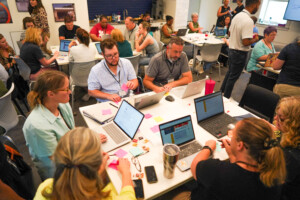Pockets of Excellence to Systems of Change: A National R&D Agenda
Key Points
-
Educators are central to driving a national R&D agenda that scales evidence-based practices and meets community needs.
-
Collaboration between school leaders, researchers, and policymakers is crucial for creating infrastructure and policies to support innovation.

By: Timothy Michalak and Jillian Doggett
Across the country, pockets of evidence-backed innovation are quietly transforming classrooms and schools. These bright spots demonstrate what’s possible when educators embrace new approaches grounded in research. Yet at the state and district levels, innovation and continuous improvement too often take a backseat. This resistance to change has never been more costly—recent NAEP results reveal continued declines in science, math, and reading scores, underscoring the urgent need for educational systems to evolve and improve.
At the same time, education leaders who make research and development (R&D) a priority, face headwinds—namely, constrained budgets, time, and capacity. They may want the best research to inform their decision-making and drive bold new approaches in their schools, but making that actually happen is no easy feat. Compounding the challenge is the hit federally-supported education R&D took this year. With the recent elimination of $900 million in federal education research funding and a presidential administration determined to cut education dollars more significantly in Fiscal Year 2026, the usual constraints school system leaders contend with are tightening. More than ever, investments in education R&D must be responsive to communities’ needs and be strategically deployed to maximize student outcomes.
Collaborative, Community-Driven Agenda-Setting
That’s why Digital Promise and the Alliance for Learning Innovation (ALI) are teaming up and convening a group of school system leaders who will shape a national education R&D agenda. Launched earlier this month, the National Education R&D Advisory Committee is made up of 13 leaders from traditional and charter school systems across the map, in communities that range from urban to rural. Nine of the districts represented in the committee are also members of Digital Promise’s League of Innovative Schools.
Through the end of the year, the committee will meet regularly to share community needs, align on common goals, and craft a national agenda to guide federal and state investments supporting education research and innovation. Ultimately, as committee member Dr. Mario Andrade, Superintendent of Nashua School District, describes it, the committee aims to ensure that “pockets of excellence will grow into systems of excellence.”
School System Leaders as Linchpins
As educational leaders closest to their communities, district superintendents and charter management organization leaders are uniquely positioned to establish a national education R&D agenda that reflects the diverse needs of their local constituencies. While researchers and policymakers play important roles, school system leaders see the day-to-day challenges and realities students and educators face. At the same time, they are responsible for creating and realizing a vision for system-wide improvement.
Through the National Education R&D Advisory Committee, these leaders will help bridge the distances between the policy and research communities and the classroom. As Sara Schapiro, ALI’s Executive Director, puts it, “Education research cannot happen in a bubble—removed from the realities of classrooms and communities. Only those closest to the classroom truly understand what students need and how to design solutions that work in their context.”
Beyond a National Research Agenda
The work of the National Education R&D Advisory Committee will expand beyond the development of a research agenda. Together, members will surface bright spots where investments in education R&D are already moving the needle on student outcomes. Those examples will inspire and inform other leaders considering ways to prioritize education R&D.
Committee members will develop practical resources to help school system leaders across the country prioritize innovation and continuous improvement. Members will also champion the creation of transformative education R&D infrastructure—such as dedicated offices and specialized staff like those established in North Carolina—and actively participate in policy conversations to translate their agenda from aspiration into reality at federal, state, and local levels.
Looking Ahead
A national commitment to evidence-based innovation in schools is overdue. School systems are charged with meeting urgent challenges—from declining academic achievement to the need to prepare learners to thrive in a rapidly changing, increasingly AI-powered world. Rather than maintaining the status quo, education leaders must prioritize evidence-based approaches and use data to identify, scale, and replicate effective practices.
The establishment of a National Education R&D Advisory Committee is an important step toward ensuring that evidence and innovation flourish in all U.S. school systems, not just a select few. Even so, a wider effort is needed to build upon the work of the committee so that this is the beginning of a movement, not a one-off initiative. To this end, Digital Promise is conducting a landscape analysis of R&D efforts at the district level; and ALI is collaborating with Transcend and Education Reimagined to develop a playbook based on ALI’s State Education R&D Policy Brief for state education leaders seeking to prioritize R&D. Both will be released later this year.
Timothy Michalak is the Director, Strategic Policy Initiatives at the Alliance for Learning Innovation. Jillian Doggett is the Director, League of Innovative Schools at Digital Promise.






0 Comments
Leave a Comment
Your email address will not be published. All fields are required.